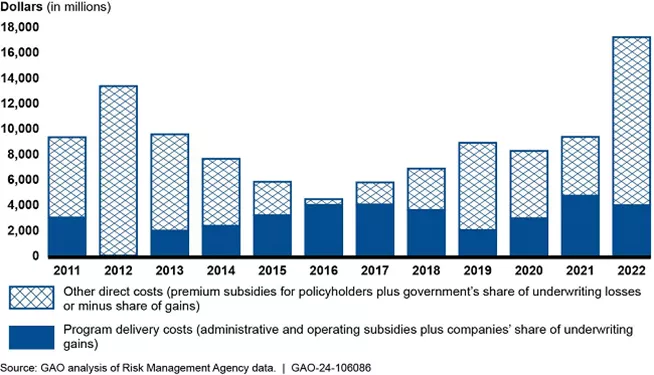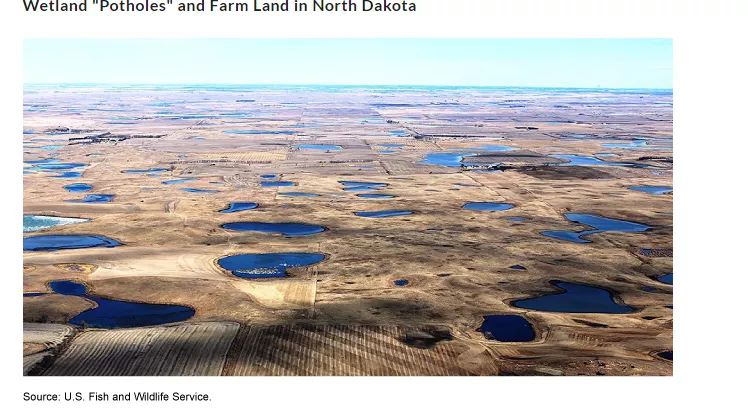Farm Programs
Issue Summary
The U.S. Department of Agriculture (USDA) administers a number of programs to support farm income, assist farmers after disasters, and conserve natural resources. However, USDA could improve how it administers some of these programs.
For instance:
- Federal crop insurance. The federal crop insurance program is required to provide the same level of premium subsidies to participants, regardless of income. In contrast, some other USDA farm programs have limits on the income participants can earn and remain eligible for payments. Not having an income limit for the crop insurance program sometimes results in relatively large subsidies for high-income participants. Reducing crop insurance subsidies for participants whose income exceeds such a limit would save millions of dollars while affecting less than 1% of program participants.
Insurance companies. To implement the federal crop insurance program, USDA partners with private insurance companies that sell and service policies to farmers in order to subsidize these policies. In 2010, USDA negotiated a set rate of return with these companies—that is, how much companies can profit from these insurance policies. However, this expected rate of return was too high compared with market conditions. Reducing this expected rate of return could save the federal crop insurance program hundreds of millions of dollars a year.
Cost of the Federal Crop Insurance Program, 2011-2022
Image

- Payments to producers. The Coronavirus Food Assistance Program (CFAP) provided producers $31.0 billion for various commodities. USDA’s Farm Service Agency (FSA) conducted spot-check reviews of CFAP payments to ensure that producers' claims were accurate, but these reviews had limitations. For example, officials from FSA’s national office selected producers for spot checks without fully considering risk factors, such as large claims for livestock. FSA should conduct additional spot checks of CFAP payments and use a more risk-based approach to selecting producers for review.
- Preserving wetlands. Draining wetlands can harm water quality and wildlife habitat. To receive certain farm program benefits, farmers must not drain wetlands on their property. However, USDA state and field office staff sometimes observe potential wetlands violations but do not report them because they believe it is not their responsibility. USDA should instruct state and field offices to report potential violations they observe.
Image

- Conservation Reserve Program. USDA’s Conservation Reserve Program seeks to offset the detrimental effects that agricultural practices can have on the environment by paying farmers to take land out of crop production and devote it to conservation. This can include establishing grasses and trees that help prevent soil erosion and provide wildlife habitat and preserving and restoring grasslands. In FY 2023, this program paid $1.8 billion for 22.9 million acres. However, USDA could improve its methods for selecting land to boost program benefits and cost-effectiveness—such as using more science-based information to estimate environmental benefits rather than staff’s professional judgment.
- USDA sugar program. USDA administers the U.S. sugar program to support domestic sugar production through tools such as limiting the supply of sugar. But the program creates higher sugar prices, which cost consumers more than producers benefit, at an annual cost to the economy of around $1 billion per year. The program also restricts the amount of sugar entering the U.S. at a low tariff. However, these tariff restrictions are applied using a method based on 40-year-old data and doesn't reflect current market conditions. This has led to fewer sugar imports than expected. USDA should evaluate its method for restricting imports.
- Foreign investment. Foreign investment in U.S. agricultural land grew to about 40 million acres in 2021, per USDA estimates. This can pose national security risks—such as when foreign interests buy land near U.S. military installations. USDA annually publishes data on agricultural land investments, which the Department of Defense (DOD), Treasury, and other agencies may review for risks. However, DOD noted that it needs more specific and timely data. USDA needs to collect, track, and share the data better—and developing a real-time data system would help.

